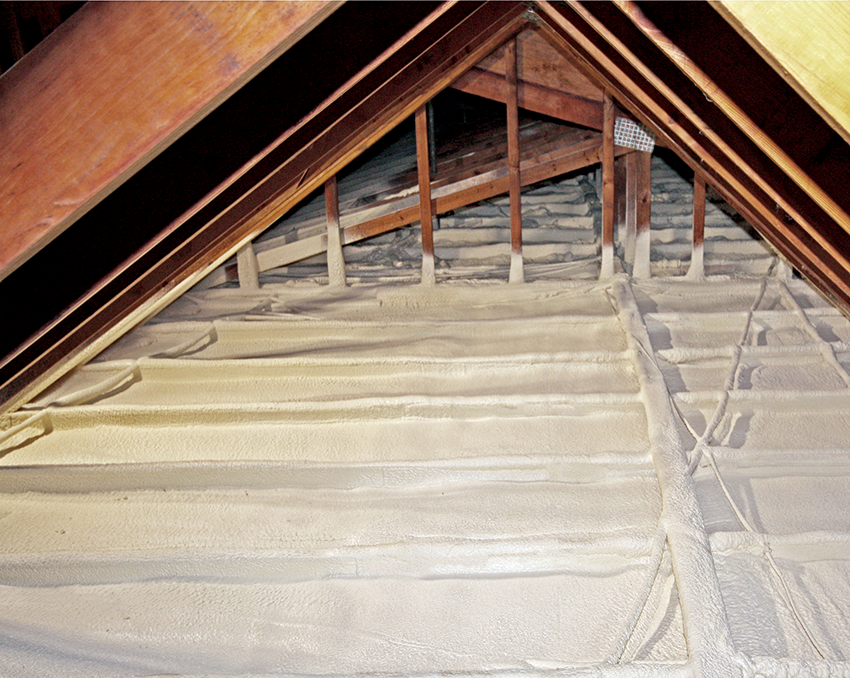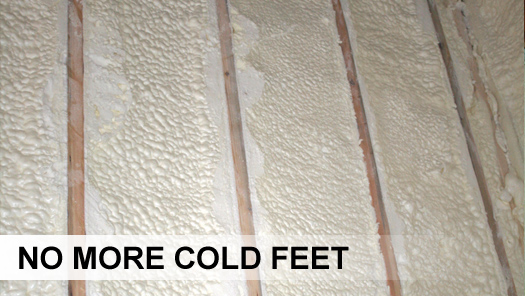
Attic / Ceiling Insulation
Spray foam does the best job insulating cathedral ceilings and attic ceilings.
Installing the right insulation in the right way will make your home more comfortable and less expensive to heat and cool.

Ceiling Insulation Areas
Even though insulation plays a critical role in keeping a house comfortable and affordable to heat and cool, many houses aren’t adequately or correctly insulated. Today, with energy costs and extreme weather on the rise, it’s more important than ever for houses to be well insulated. Ceiling insulation is an important component in any home’s weatherization plan.
Foam Tech specializes in all kinds of insulation, including ceiling insulation. When one of our professionals inspect your home, we'll discover exactly what spaces need these services.

Cathedral Ceiling Insulation
When the ceiling in a living space is sloped rather than flat, it’s usually referred to as a cathedral ceiling. The insulation space in a cathedral ceiling is limited because of the width of the rafters. Usually this type of ceiling has insulation baffles installed between rafters to maintain roof ventilation. The baffles are secured to the underside of the roof sheathing, and fiberglass batt insulation is fit between rafters and over the insulation baffles. Alternatively, the spaces between rafters in a cathedral ceiling can be filled with spray polyurethane foam (SPF), the most popular type of spray foam insulation. SPF provides higher R-value while also eliminating energy-wasting air leaks.
This is the same as attic floor insulation. Fiberglass batts, blown-in cellulose and blown-in fiberglass insulation are most commonly installed in the attic. Most houses have inadequate levels of attic insulation according to current Dept. of Energy recommendations. Fortunately, this deficiency can be corrected affordably in most cases.


Basement ceiling insulation
This can only insulate the floor directly above the basement. It does nothing to make the basement more comfortable. Home energy experts recommend that basement walls be insulated (usually with rigid foam insulation) to bring the basement inside the home’s building envelope.
Insulating the basement walls benefits your above-grade living space as well as the basement.
Foam Wall Insulation
It's not surprising that foam insulation is gaining popularity. Rigid foam insulation board is very versatile because of its high R-value, water resistance and air-sealing ability. Spray foam insulation can also be used in a wide variety of ways. Both insulation materials can perform well in walls.
To see how foam insulation can benefit your home, contact Dr. Energy Saver! Our contractors are trained and certified in using this product properly.
Rigid foam insulation is best for basement and crawl space walls
Rigid foam insulation provides an R-value that can range from about R-4 per in. to over R-6 per in., depending on what type of foam is used to make the panel. In most applications, the foam board is glued to the foundation wall; joints between boards are sealed with 1-part spray foam and then covered with aluminum tape to keep the insulation coverage continuous. In a basement, building codes typically require that this layer of rigid foam insulation be covered with a fire-rated wallboard material.
 New life for old walls. Injection foam has the perfect consistency to flow into wall cavities. It can stop uncomfortable drafts due to air leakage, making the home’s building shell much more energy efficient.
New life for old walls. Injection foam has the perfect consistency to flow into wall cavities. It can stop uncomfortable drafts due to air leakage, making the home’s building shell much more energy efficient.
Injection foam insulation can upgrade insulation levels in wood-frame walls
Most existing wood-frame walls will either have no insulation installed in wall cavities (between studs) or fiberglass insulation that isn't performing well. In either case, energy efficiency and comfort can be dramatically improved by filling wall cavities with injection foam, a special kind of spray foam designed specifically for use in building cavities. This water-based foam insulation has the consistency of shaving cream when it's injected into walls through access holes. It flows around obstacles and existing insulation, filling gaps completely to seal air leaks and provide more complete insulation coverage. It hardens after a few minutes and will not settle, shift or compress like fiberglass insulation.
